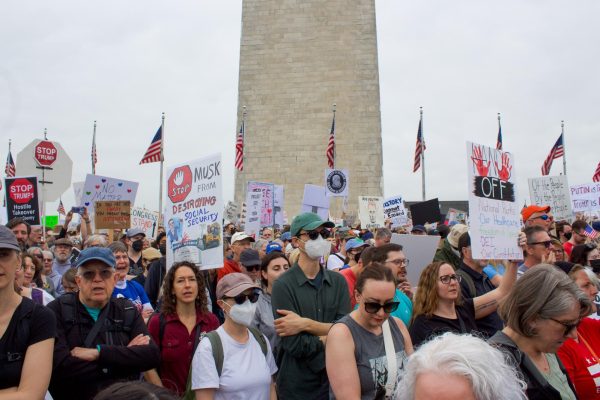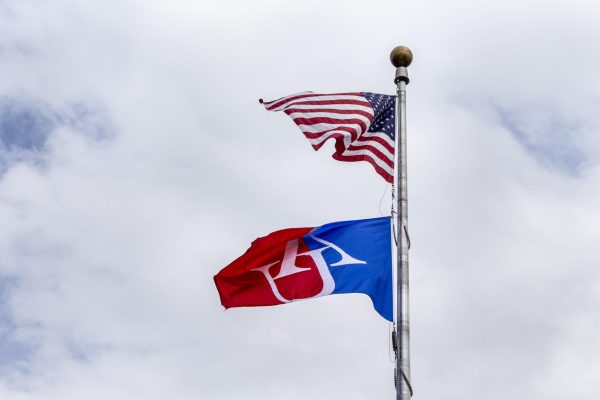Living Below a Living Wage
The legislation named “large companies” as those with at least one billion dollars in revenue and stores at least 75,000 square feet in size. However, some saw the bill as a specific attack on Wal-Mart’s imminent plans to open stores in the District, and Mayor Gray vetoed the bill.
“The bill is not a true living-wage bill because it would raise the minimum wage only for a small fraction of the District’s workforce,” Gray explained in a letter written to the council following his veto.
His sentiments mirrored those of Walmart spokesman Steven Restivo, who repeatedly spoke out against the LRAA as ineffective public policy. In a letter to the editor of Georgetown’s The Hoya, Restivo wrote, “the legislation does not create a level playing field and imposes arbitrary costs on only a handful of businesses in DC That’s bad public policy.” Wal-Mart waged a strong campaign against the bill, creating the advocacy group Don’t Block DC Progress to petition for support. After the council passed the bill, the company even went as far as halting plans to open three stores in the District. The Mayor’s veto set back into motion the company’s plans to expand into DC.
But what Mayor Gray failed to realize by defeating this bill is that it offered a rare opportunity to endorse and enforce a policy that requires large corporations—including big box stores like Wal-Mart—to treat its workers in an ethical manner by paying them a fair wage to live on.
Timothy Noah, journalist and author of The Great Divergence: America’s Growing Inequality Crisis and What We Can Do About It, has spent years covering ever-increasing income inequality in the United States and cites the lack of upward mobility for low wage workers as key component of this growing divide. He says that the decline of the labor movement is partly to blame for the inaction or lack of momentum in raising the minimum wage, considering the movement’s significant historic role in improving the lives of workers.
Over the years, critics of raising the minimum wage to meet a more “living wage” standard have argued that it eliminates low wage jobs when small businesses cut costs by firing employees. This claim, however, is an unreliable. In its attempt to raise the minimum wage, the Large Retailers Accountability Act tried to bypass any mention of small businesses and direct the legislation at those unduly benefitting from a depressed minimum wage—big corporations.
This was not the first time Wal-Mart waged a minimum wage battle with a major city. In 2006, the corporation similarly threatened to abandon plans to build stores in Chicago when the city council voted to force big retail companies to pay employees $10 an hour with benefits. Former Mayor Richard Daley stepped in and vetoed the measure. As of this year, Wal-Mart has nine stores in Chicago.
The fact that Wal-Mart has repeatedly found itself in this position is indicative of a larger economic struggle: low-wage workers propel large corporations to sky-high profits while earning barely enough to survive. As a result, efforts by public officials have shifted from merely raising the minimum wage to attempts to force large retailers who employ the majority of America’ s lowest paid workers to raise wages.
A look at the numbers only emphasizes the importance of holding corporations like Wal-Mart accountable. A report by the National Employment Law Project found that 66% of low-wage workers are employed, not by small businesses, but rather by large corporations in a strong financial position.
In fact, with a workforce of 1.4 million people, Wal-Mart is the largest low-wage employer in the nation, just beating out McDonald’s and Yum! Brands, which owns Taco Bell, Pizza Hut and KFC. That workforce helped deliver $469 billion in revenue for the company in fiscal year 2013. These high profits are made by a highly productive and effective low wage workforce, which is why the legislation was an essential step in making sure that the exploitation of workers by large corporations is not protected by the minimum wage.
Large corporate detractors argue that increases in the minimum wage would force businesses to cut their payrolls and reduce employment opportunities. Wal-Mart employees currently earn on average $8.81 per hour—28 percent less than those who work for other large retailers. Compare this amount to its rival retail chain Costco, which on average pays its employees $21.96, yet somehow still manages to make a profit. The myth that requiring Wal-Mart to pay $12.50 would hurt its bottom line is nonsensical.
Established by the Fair Labor Standards Act of 1938, the minimum wage was meant to ensure the welfare of workers with a baseline wage of 25 cents. Since its inception the minimum wage rate has been raised 22 times, but in that time it has failed to keep up with the cost of living. While the minimum wage rose from $1.60 to $7.25 between 1968 and 2009, its real purchasing power decreased due to inflation. When adjusted for inflation, the minimum wage fell from $10.70 to $7.90.
As a result, minimum wage has become less of a tool to ensure the welfare of workers and more of a means for enforcing and maintaining greater income inequality. What once strived to serve as a “living wage,” it has become nothing but a guarantee of the bare minimum.
At the moment, the only city to have made some noticeable strides is San Francisco, with the highest mandated minimum wage in the country ($10.55). This is illustrative of where the minimum wage debate has been stuck—at the super localized level.
In his State of the Union speech earlier this year, President Obama claimed that the minimum wage should be increased and indexed to the cost of living. Additionally, Senator Tom Harkin and Representative George Miller have introduced legislation to establish a new minimum wage of $10.10, a number in line with a study by the Center for American Progress that advocates a minimum wage of one half of the average income.
Karla Walter, associate director of the American Worker Project at the Center for American Progress, thinks large retailers have the power to raise wage and benefit standards in D.C. and across the nation and must do so.
“Its extremely important that large retail employers pay family-supporting wages and benefits,” Walter says. “Currently, many retail workers struggle to afford even the basics. Just paying rent, putting groceries on the table, paying for quality daycare for their kids is a virtual impossibility for a parent earning the minimum wage in the DC region.”
This refusal to pay a living wage has placed quite the burden on workers and even public programs. A report by the House Committee on Education and the Workforce found that workers at a single 300-employee Walmart Supercenter store rely on almost $1 million in public benefits. The report found that workers at a Wisconsin Walmart had to turn to state welfare programs such as the Supplemental Nutrition Assistance Program, school lunch programs, and Section 8 housing and others due to low wages and benefits.
The current state of the minimum wage further punishes hard-working Americans as they put in many hours but receive little returns—all while the major low-wage employers enjoy record profits. Conditions such as these are why legislation like the LRAA is not arbitrary but necessary in ensuring that workers can not only survive but also thrive. •
_
Illustration by Ellyse Stauffer._







